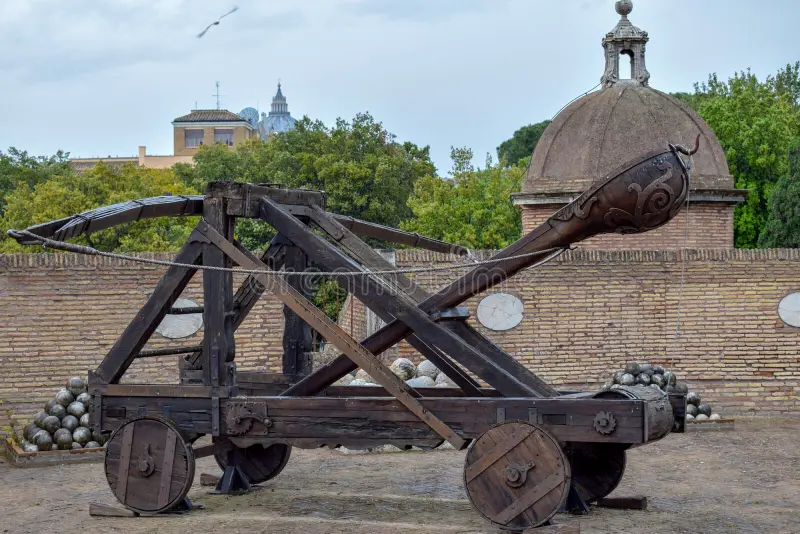Your basket is currently empty!
For centuries, popular imagination, fueled by films, video games, and often simplified historical accounts, has painted a vivid picture of medieval warfare: massive catapults hurling colossal stones against fortified castle walls. While the image is undeniably iconic, it perpetuates a pervasive myth: that these formidable siege engines were solely used to hurl rocks. The truth, as is often the case with history, is far more nuanced, intriguing, and frankly, a lot messier. The catapult, and its various iterations like the trebuchet and onager, were remarkably versatile weapons, designed to inflict damage, sow terror, and break the will of a besieged enemy through a diverse arsenal of projectiles that extended far beyond simple masonry.
The misconception likely stems from the prominent role stones undoubtedly played. Large, heavy stones were effective for battering down walls, collapsing towers, and creating breaches. Their sheer kinetic energy, delivered with immense force, could crumble even the stoutest defenses over time. Quarries near siege sites would have been exploited, and readily available river rocks or even repurposed building materials would have been utilized. This primary function—destruction of fortifications—is undeniably a key aspect of siege warfare and naturally leads to the association of catapults with stones.
However, limiting the catapult’s ammunition to just rocks dramatically underestimates the ingenuity and ruthless pragmatism of ancient and medieval military engineers. Their objective was not merely to breach walls, but to achieve capitulation. This meant employing tactics that would demoralize the defenders, spread disease, ignite fires, and generally make life within the besieged stronghold an unbearable hell.
One of the most insidious and effective uses of siege engines involved biological warfare. Long before germ theory, commanders understood the devastating potential of disease. Animal carcasses, particularly those of diseased animals, were routinely launched into besieged cities. Horses, cows, and even human corpses—often victims of plague or other epidemics—would be flung over walls. The stench alone would have been overwhelming, but the true terror lay in the spread of pestilence. Fleas carrying bubonic plague, bacteria from decomposing flesh, and general unsanitary conditions would quickly turn a confined city into a death trap, crippling the defenders from within. The Mongols, in particular, are famously (or infamously) associated with this tactic during the siege of Caffa in 1346, often cited as a potential catalyst for the Black Death’s spread into Europe.
Beyond the grotesque, incendiary projectiles were another staple of the catapult’s arsenal. Fire was a constant threat in a pre-modern city, where most structures were made of wood and straw. Pots filled with Greek fire, a mysterious and highly effective ancient incendiary compound, or simply pitch, oil, and resin, would be set alight and launched. Bundles of flaming faggots (sticks) or straw, sometimes dipped in flammable liquids, were also used to set buildings ablaze, creating chaos and forcing defenders to divert resources to firefighting efforts. The aim was not only direct destruction but also to create smoke, panic, and to deny the enemy shelter and supplies. Imagine the terror of seeing flaming projectiles arcing through the night sky, threatening to engulf your home and supplies.
The psychological impact of siege warfare was paramount, and catapults were instruments of terror as much as destruction. To this end, human remains were not just used for biological warfare; they were also employed to break enemy morale. Decapitated heads of captured soldiers, or even the bodies of high-ranking enemy combatants, might be launched over the walls as a gruesome warning. This was a direct assault on the enemy’s spirit, a demonstration of ruthless power and a clear message of what awaited them if they continued to resist.
Furthermore, propaganda and psychological warfare took a surprisingly literal form. Messages, threats, or even false intelligence could be wrapped around stones or put into containers and launched into the city. While not as common as other projectiles, it demonstrates the creative ways siege engines were adapted to serve various strategic goals.
Less commonly depicted, but equally practical, were specialized containers filled with a variety of materials. For instance, sometimes smaller stones, gravel, or even sharp metal scraps would be packed into bags or nets and launched. Upon impact, these would burst open, showering an area with deadly shrapnel, effectively acting like a giant, ancient shotgun blast against exposed troops on the ramparts or in the courtyards. This was particularly effective against massed formations or those attempting to repair breaches.
Finally, the design of the catapult itself often dictated the type of projectile used. While trebuchets, with their massive counterweights, excelled at launching very heavy objects, smaller onagers or mangonels could be more easily adapted for a wider range of lighter, specialized payloads, including the incendiary and biological agents mentioned above. The versatility of these machines was a testament to the engineering prowess of the time and the grim realities of siegecraft.
In conclusion, the enduring image of the catapult as a mere stone-throwing machine is a simplification that diminishes the sophisticated and often horrifying reality of ancient and medieval siege warfare. These powerful engines were not just blunt instruments of destruction; they were versatile tools of war, capable of delivering a diverse array of projectiles designed to dismantle defenses, spread disease, ignite fires, and ultimately, break the will of the besieged. So, the next time you envision a catapult, remember that its true arsenal extended far, far beyond the humble boulder, encompassing a range of terrifying and ingenious implements of war.

